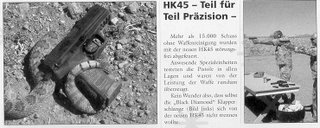And, when I was first seriously considering buying one, the Desert Eagle was one I asked about. The Police Supply shop I went to in Miami said that most customers liked to hold one, but not seriously buy one, and they really didn't want to hold onto what amounted to a $1200 piece of furniture.
$1200 was rather steep for me at the time, so I looked at Glocks, Tauruses, and H&Ks.
I was very impressed with the H&K.
So, I bought one in 9mm, with a stainless slide.
Yes, I hear you guffawing, and understandably so. What on earth was I doing with a 9mm in Alaska?
I wasn't in Alaska at the time. I was in South Florida. And I chose the 9mm for economic reasons. Later, I would desire a more serious caliber and get one in .45.
 But at any rate, allow me to give you my rundown on the first pistol I ever owned, and by far the finest I have every shot in a non-magnum caliber: the H&K USP.
But at any rate, allow me to give you my rundown on the first pistol I ever owned, and by far the finest I have every shot in a non-magnum caliber: the H&K USP.It was first introduced around 1994, as H&K's entry into the .40 S&W market. It had the misfortune of appearing right around when Klinton's farcical Assault Weapons Ban went into effect. Therefore, it was extremely hard to find pre-ban hi-cap mags.
Forget it if you were looking for something in .45. The model in that caliber was introduced in 1995.
It was designed around the same time SOCOM was looking for a new pistol (in .45, you wonderneeners). H&K took up the bid, and developed the handgun (known as the Mk. 23). Alongside this development, they designed the USP for the civilian & law-enforcement markets. Therefore, much of the engineering that went into the Mk.23 is also found in the USP.
It utilizes a modified Browing-type recoil action (which just about every semiauto uses nowadays). What sets it apart is the modular approach to its construction. You can have an armorer switch out a few parts, and voila, a pistol with or without a safety, with or without a decocker, SA/DA, or DAO, or mix and match.
 Fullsize versions feature a patented recoil buffering system. I don't know the ins and outs of the engineering involved, but H&K boasts that it reduces felt recoil to 600 newtons, while comparable .45s suffer nearly twice that much of a pounding each time the trigger is pulled.
Fullsize versions feature a patented recoil buffering system. I don't know the ins and outs of the engineering involved, but H&K boasts that it reduces felt recoil to 600 newtons, while comparable .45s suffer nearly twice that much of a pounding each time the trigger is pulled.It has the double advantage of reducing wear & tear, and better controllability for the shooter. I can personally attest to the latter. My USP is the most comfortable .45 I have ever shot.
Like most semiautos coming out on the market, the frame is polymer. I've had a few people call my USP a Glock at first glance (which I personally find rather insulting. It's like calling a BMW a Volkswagen). But while Glock may have popularized plastic, it was H&K who first made a polymer frame a reality, with the VP70.
Accuracy, of course, depends upon the shooter. I can personally attest to having shot a moving grouse through a very narrow open lane of fire at 40 feet, and have shot another bird out of the air at 15 yards on the draw.
And, it will pretty much eat anything you feed it. I fed my 9 Winchester SXT, Cor-Bon, Georgia Arms, and even that crappy Wolf ammunition. It likes them all. The .45 has eaten Cor-Bon and American Eagle, without so much as a hiccup--even at 30 below (which my Deagle does not like).
 The only real drawback to the gun are the accessory rails. They're pretty much proprietary, as opposed to something compatible with Weaver- or Picatinny-style rail systems. This means that you usually have to buy an adapter for a tactical light and/or laser sight system.
The only real drawback to the gun are the accessory rails. They're pretty much proprietary, as opposed to something compatible with Weaver- or Picatinny-style rail systems. This means that you usually have to buy an adapter for a tactical light and/or laser sight system. However, the pistol that is supposed to come out of the HK45 project (which the featured clipping out of a German magazine is the only real hard evidence we have of it just now is supposed to feature a more compatible rail system (along with some ergonomical improvements made with the P2000).
However, the pistol that is supposed to come out of the HK45 project (which the featured clipping out of a German magazine is the only real hard evidence we have of it just now is supposed to feature a more compatible rail system (along with some ergonomical improvements made with the P2000).Some would consider the price tag a drawback as well. This gun can run about $200 more for a comparable Glock, but I consider the quality worked into it to be well worth it, as well as the safety features of the USP not found in the Glock (manual safety, decocker, and that you don't need to pull the trigger to disassemble it).
All in all, a very fine piece of German craftsmanship.

No comments:
Post a Comment